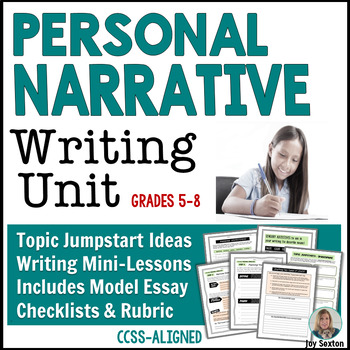Narrative Writing - Personal Narrative Unit Grades 5 - 8
- Zip
What educators are saying
Also included in
- Narrative, Argumentative, and Informational Writing will be so much easier to teach with these step-by-step units that lead your students seamlessly through the process! Grab this bundle at a nice discount and have all three standards-based writing units. You’ll love the scaffolded activities thatPrice $19.99Original Price $25.40Save $5.41
Description
Narrative Writing – This “print and teach” standards-aligned Personal Narrative Unit contains engaging mini-lessons and activities that will lead your students through the process of writing a strong narrative piece. A mentor text is included along with revising techniques that help students improve their writing!
More from teachers who have used this resource:
- "This was SUPER easy to use and it got even my most discouraged writers writing! Thank you!"
- "The content has awesome, just-right lessons. The lay-out is student-friendly and the pacing is perfect."
- "This helped me so much with teaching each step of the writing process. Loved it!"
- "Great resource! My students wrote great personal narratives using this resource!"
- "This is absolutely amazing! Broken down into manageable steps and bulleted instructions for each step. I LOVE this!"
**************************************************************************************************
NOTE: This is a print resource. It is not digital. For the DIGITAL version of this resource, click on Narrative Writing - Personal Narrative DIGITAL for Google Drive or Microsoft
**************************************************************************************************
This Resource Contains:
1. WRITING A PERSONAL NARRATIVE - The elements of a personal narrative are explained and a brainstorming prompt gets students thinking about a recent experience
2. MENTOR TEXT – “All in a Moment” Personal Narrative mentor text provides students with a strong model for their writing
3. TOPIC JUMPSTARTS/ BRAINSTORMING – Ten different “situation” topics are provided. Students brainstorm and jot down information about an experience they recall for each
4. NARROW DOWN YOUR TOPIC – Students are prompted to narrow down the experience they choose to the most meaningful part of that experience
5. PLANNING YOUR WRITING – An organizer where students list details in sequence as they recall their experience for setting, characters, events, and closing reflection
6. DRAFTING YOUR LEAD – Examples of two styles of leads are provided, and students then compose a lead for each style and compare/discuss with a peer
7. DRAFTING YOUR NARRATIVE – A step-by-step checklist to guide students and keep them on task as they draft the narrative
8. PUNCTUATING DIALOGUE – Examples that demonstrate rules for punctuating dialogue and practice sentences for students to complete
9. TRANSITIONS – A list of transitions and transitional phrases and clauses commonly used in narrative writing for student reference as they draft
10. AWESOME ADJECTIVES – To emphasize description, 15 vivid adjectives are listed in word boxes, and students fit the adjectives into the sentences provided
11. SENSORY ADJECTIVES – A list of 105 sensory adjectives for students to use, categorized under taste, sight, touch, smell, and sound
12. VOICE IN YOUR WRITING – Several techniques to enhance voice in the narrative are demonstrated for students in a checklist style. Students apply these techniques as they draft and revise.
13. REVISING YOUR DRAFT – A series of revision activities to strengthen use of dialogue, specific details, adjectives, transitions, voice, and concluding reflection
14. EDITING CHECKLIST – A writing conventions checklist students follow to carefully edit their revised drafts
15. COMPLETING YOUR FINAL COPY– Specific directions for typing the final copy are outlined along with an explanation of how the unit will be graded --Process grade and Final Copy grade
16. PROCESS GRADE HALF SHEET – A quick and easy grading sheet for formative assessment. Students are graded on the process work –brainstorming, rough draft, revising activities, etc.
17. NARRATIVE WRITING RUBRIC – A 4-point rubric for grading the final copy of the narrative.
18. TEACHER DIRECTIONS FOR THE UNIT – A step-by-step plan for teaching the unit from beginning to end. Includes Common Core Standards.
You will enjoy the results when using this resource! You’ll find just the right mix of instruction, modeling, and practice to lead your students to producing the great writing they are capable of!
Please open the PREVIEW to get a closer look.
Thanks! --Joy
You might also like:
Informative Essay Writing: 5 Informational Essays w/Guided Writing Templates 6-8
TASK CARDS for BETTER WRITING: Sentence Fragments
TASK CARDS for BETTER WRITING: Run-On Sentences
TASK CARDS for BETTER WRITING: Verb Tense Consistency
TASK CARDS for BETTER WRITING: Repetitive Wording
Task Cards for Better Writing: BUNDLE
---Yes! Join my list to receive Teaching Tips, New Product Updates, and FREEBIES from Joy






